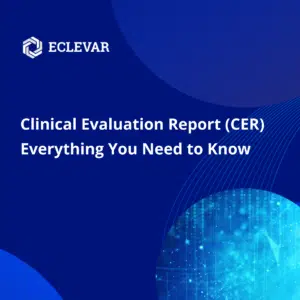A Clinical Evaluation Report (CER) is a document that exposes a clinical assessment’s conclusions of a medical device. The report must provide evidence, that conveys safety and regulatory compliance for the manufactured product in question by structuring an analysis of pre-market and post-market clinical data.
There has been significant evolution in the European regulatory landscape over the past 10 years, particularly in terms of requirements for clinical evaluation. These changes have been driven in part by a series of medical device failures, which fuelled a perception, particularly amongst regulators and clinicians, that clinical evidence for medical devices was not receiving sufficient scrutiny in Europe.
Understanding the requirements for a medical device CER is important so you’ll be able to plan and execute the writing process of the report, that will be read and understood by an agency or notified body.
Substantial amendments were made to Annex 7/X (clinical evaluation), including:
- clinical investigation required for all Class III and implantable devices; any decision not to undertake a clinical investigation for these devices must be duly justified
- clinical evaluation must be documented as part of the technical documentation
- the clinical evaluation and its documentation must be actively updated with data obtained from Post-Market Surveillance (PMS)
- if Post-Market Clinical Follow-up (PMCF) is not deemed necessary, this must be duly justified and documented.
In this article we are going to explain the significance of Clinical Evaluation Reports for medical device market access in 2023 and give you expert tips to write and validate a report that ensures your products are compliant with regulations. Keep reading!
Clinical Evaluation Report for Medical Devices
The European Union Medical Device Regulation (MDR) 2017/745 was first released in 2017 by the European Parliament and the Council of the European Union. This regulation has the intent to ensure a high standard quality for any medical devices that are produced in, or supplied to, member countries of the EU.
For that reason, MDR requests an evaluation report of the safety and performance of medical devices that must be completed through the compliance of the General Safety and Performance Requirements (GSPR) and present clinical evidence, obtained from the evaluation of the clinical data.
Is important to know that the Clinical Evaluation Report must be updated periodically throughout the entire time the device remains in market. You can learn more about the specifics MDR requirements on the MDCG guidelines MDCG 2020-5, MDCG 2020-6, MDCG 2021-6, MDCG_2019_9 rev.1, MDCG_2022-21, MDCG_2023-3, and MDCG 2020-13.
Cumulatively these changes have shaped and reinforced the current practices, particularly with respect to parameters which affect the validity of the process and conclusions drawn:
- scope and clinical evaluation planning
- data collection methods
- data appraisal and analysis
- data mapping, benefit-risk evaluation and conclusions on sufficient clinical evidence
Overview of the Clinical Evaluation Process
Annex XIV of the EU MDR defines the requirements for the clinical evaluation process. These are broadly consistent with the process as described under EU AIMDD and EU MDD and expanded in the MEDDEV 2.7/1 revision 4 guidance: Planning, data collection, data appraisal, data generation (if indicated), data analysis and conclusions, continued data collection in the post-market phase to maintain and update the clinical evaluation.
Although this sequence is frequently represented as a step-by-step process, in practice, interaction may create feedback loops within the cycle. Examples of such interaction include:
- results from the SOTA evaluation may indicate revisions to the risk evaluation or clinical evaluation plan are required before the collection of further post-market data
- there may be no relevant data identified at the data collection stage, necessitating a re-evaluation of the clinical evaluation or clinical development plan
- following data appraisal, it may become apparent that there is not sufficient literature to feed into data analysis, which may then require a revision of the clinical evaluation plan (CEP)
- conclusions from the clinical evaluation may indicate a revision to the clinical evaluation plan, such as additional pre-market studies or a change to the indications for use, or a revision to the risk analysis and related risk management documentation
The structure of a CER document
Having defined a robust clinical evaluation plan and specified relevant outcome parameters with appropriate benchmarks based on the state of the art (SOTA), the rest of the clinical evaluation process is comparatively straightforward.
As indicated in the introduction to this white paper, so much has been written about systematic reviews, literature search methodology, data appraisal and analysis, that this paper will not attempt to expand on these topics.
A few key points which may be useful to know for the creation of compliant clinical evaluation reports are described below:
- Literature search and methodology
- Data collection
- Data appraisal and analysis
- Evaluation of benefit-risk ratio
- Conclusion
The length of the document depends on the potential risk the device offers to a patient, so products that are more potentially harmful require a more in-depth report. But, regardless of the length, the structure remains the same:
Summary
The first session is the summary. It consists of a solid overview of the entire report. It must contain the intended target groups, the medical indications and a list of benefits and possible risks that the product can offer, as well as the conclusion of the medical evidence regarding its efficiency.
Scope
The next stage is to write the scope element. In that session you must include the technical and clinical aspects, incorporating a clear explanation of the technologies and working of the device. The details such as the model, size, software version (when applied) and available accessories of the product must also be mentioned.
Here are some other aspects of the device that should be indicated in the scope:
- Name and address of the manufacturer organization
- Picture or diagram of the device
- Classification by group
- Description of the device’s planed purpose and how it achieves them
- Precautions when using
- Manufacturer’s claims on performance and safety
- Accurate physical and chemical description of the materials
- Mechanical and physiochemical characteristics
- Indication on if the technology is new, new application of existing technology or if it is an innovation
- Changes made since the last CER application.
Clinical Background
It’s required that any evaluation report includes extended research on the clinical context that the medical product is inserted. The sources and search methods must be explained, as well as any applicable standards or guidance which may impact the device. The medical conditions and how often the condition occurs in the general population are also a part of the clinical background.
Other aspects of the session include:
- Quality control measures
- Benefits and risks of other available therapeutic options
- Any hazards the device may offer
- Information about the clinical using of the device.
Conclusion
After all the heavy analyse is structured, the conclusion wraps more directly the content of the report, comparing the manufacturer’s safety claims, along with the information materials, to the data result. Any potential risks or discrepancies must be included at the conclusion. In the case of an inconclusive evaluation, the report should address further research.
Dates and References
At the end of the report some indicators are included, in a format that is similar to an academic appendix. Besides the references to the analysis, you must insert:
- The dates of the current and next clinical evaluation
- A signed statement from the evaluator (along with their qualifications)
- Final release data from the manufacturer.
Writing a Highly Effective CER Report
As you now know, writing a Clinical Evaluation Report is as important as it is a thorough job. At ECLEVAR our team is led by former notified body leadership that have significantly contributed to MDCG guidance documents on clinical evaluation. That’s why we know what agents are expecting, we will prepare your team and documentation accordingly to their specifications.
Contact us to learn more about our services through our channel.

